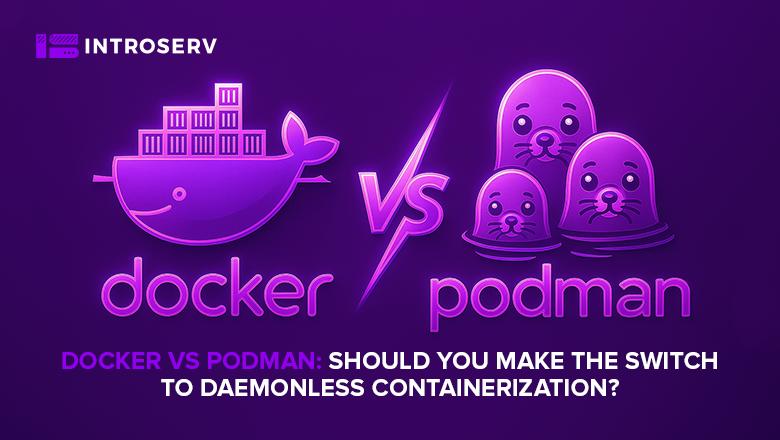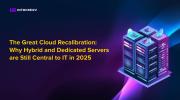For years, Docker has been synonymous with containers. It's been the go-to tool for developers and operations teams alike, revolutionizing how we build, ship, and run applications. But as the container landscape matures, a new challenger has emerged, promising a fundamentally different approach: Podman. If you've been working with containers for a while, you've likely heard the buzz. But what exactly is Podman, and should you consider making the switch from your trusty Docker setup? Let's dive in and explore this compelling, enterprise-grade alternative.
Ditch the Daemon: Why Podman is the Secure Alternative
Docker pioneered modern containerization with a robust, yet centralized, client-server architecture. At its heart lies the Docker daemon – dockerd, a persistent background service that typically runs with root privileges. This daemon acts as a central authority, managing all operations: building images, running containers, and orchestrating networks and volumes via a Unix socket.
While effective, this model has significant implications:
- Single Point of Failure: The daemon is a critical process. If it crashes or needs to be restarted, all managed containers are stopped by default. While Docker offers a "live restore" feature that allows containers to keep running during daemon downtime, this must be manually enabled and is not the default configuration. Many developers have experienced the frustration when a daemon update or unexpected crash disrupts their entire local development environment.
- Security Risk: Running a centralized service with root privileges creates a substantial attack surface. Any compromise of the daemon or the socket can grant an attacker root access to the host system. In multi-tenant environments or CI/CD pipelines, this represents a serious security concern.
Podman, developed by Red Hat, represents a paradigm shift. Its primary differentiator is its daemonless architecture. Podman commands interact directly with the OCI runtime – typically runc or crun and the system. When you execute a container, it becomes a child process of the calling user, managed by systemd – not a centralized daemon.
Crucially, this architecture enables rootless containers as the default mode. Podman allows you to run containers as a regular, non-root user within a User Namespace. This adherence to the Principle of Least Privilege significantly hardens your host system, as a container escape would only grant access to the user's limited permissions.
Important note: Docker has supported rootless mode since version 19.03, but it requires manual configuration and is not the default setup. Most Docker installations still run with a root daemon, whereas Podman makes rootless the primary, recommended approach.
Feature Showdown: Architecture and Capabilities
Both engines are OCI-compliant, meaning they can run the same container images. However, their underlying approach leads to meaningful differences that impact security, performance, and workflow:

The Performance Reality: Where Each Excels
Podman advantages:
- Faster cold starts: No daemon to initialize means your first container starts immediately
- Lower baseline resource consumption: Without a persistent daemon, your system uses less memory when containers aren't running
- Better isolation: Each container runs as an independent process, improving fault isolation
Docker advantages:
- Faster batch operations: The daemon can optimize multiple concurrent operations more efficiently
- Better networking performance in rootful mode: Direct bridge networking is faster than slirp4netns used in rootless setups
- Mature ecosystem integration: IDE plugins, CI/CD tools, and third-party services often have better Docker support
For most development workflows, the performance differences are negligible. The choice comes down to security posture and operational requirements rather than raw speed.
Migrating to Podman: The Practical Reality
The path from Docker to Podman is surprisingly smooth, thanks to intentional compatibility decisions by the Podman team:
CLI Compatibility
Podman's CLI is designed as a drop-in replacement for Docker's. Most commands work identically:
- docker run → podman run
- docker build → podman build
- docker ps → podman ps
Linux users can simply create an alias: alias docker=podman and continue using familiar commands that begin with the word "docker". On macOS and Windows, Podman Machine provides a lightweight VM that mimics the Docker Desktop experience.
Docker Compose Support
Podman now includes native podman compose support. This built-in functionality parses and executes existing docker-compose.yml files with high compatibility. For most standard Compose files, migration requires zero changes.
There's also the community-maintained podman-compose Python-based tool, but the native podman compose command is now recommended for better stability and integration.
Kubernetes-Native Workflow
This is where Podman truly differentiates itself. Its native concept of "pods" is identical to Kubernetes pods, enabling two powerful workflows:
- Local Pod Management: Run multi-container applications locally in a true pod structure – shared network namespace, storage; improving parity between development and production Kubernetes environments.
- YAML Generation: The podman generate kube command converts running containers or pods directly into deployable Kubernetes YAML manifests. This dramatically streamlines the developer-to-ops handoff process. You can develop locally with Podman, then deploy to Kubernetes with generated configs that accurately reflect your tested setup.
Migration Challenges: The Honest Truth
While migration is generally smooth, there are real challenges to consider:
- Docker-in-Docker scenarios Running Docker inside containers, common in CI/CD is more complex with Podman. While podman run --privileged exists, the semantics differ, and some DinD workflows require rethinking.
- Networking differences Docker creates a bridge network by default with direct host access. Podman's rootless mode uses slirp4netns for user-mode networking, which has different performance characteristics and may require port forwarding adjustments.
- Ecosystem tooling gaps While improving rapidly, IDE integrations, GUI tools, and third-party services often have better Docker support. Podman Desktop helps, but expect occasional friction.
- Volume permissions Rootless containers can encounter permission issues with bind mounts. Understanding UID/GID mapping in user namespaces becomes necessary for some workflows.
- Docker-specific flags Some Docker-specific command flags don't have Podman equivalents or behave differently. Review your scripts carefully during migration.
Building Beyond Dockerfiles: Introducing Buildah
Podman uses Buildah internally for image building, but Buildah deserves special mention as a standalone tool. While Podman provides podman build for Dockerfile compatibility, Buildah enables scriptable, Dockerfile-free image construction.
With Buildah, you can:
- Build images using shell scripts instead of Dockerfiles
- Fine-tune individual layers programmatically
- Create images without requiring root privileges at any stage
- Integrate image building directly into your CI/CD pipelines as code
Example Buildah script:
bash
#!/bin/bash
container=$(buildah from alpine:latest)
buildah run $container apk add --no-cache python3
buildah config --entrypoint '["python3"]' $container
buildah commit $container my-python-app
Real-World Adoption: Who's Using Podman?
Podman is no longer experimental – it's production-ready and widely adopted across the industry.
- Red Hat Enterprise Linux (RHEL) 8+ Podman is the default container engine in RHEL 8 and later, with Red Hat having removed Docker entirely from the official repositories. This represents a major enterprise commitment and validates Podman's production readiness for mission-critical workloads.
- Podman Desktop Growth Podman Desktop has surpassed 3 million downloads, with major enterprises migrating thousands of engineers to the platform. Red Hat has announced its intention to contribute Podman to the CNCF, demonstrating the project's maturity and industry-wide adoption momentum.
- GitLab CI/CD GitLab officially supports Podman for runners, with documented configurations for both rootless and privileged setups. Organizations use Podman runners to build container images securely in CI pipelines, particularly in OpenShift environments and self-hosted infrastructure.
- GitHub Actions Self-hosted GitHub Actions runners can run on Podman, with Red Hat providing containerized runner images and official Podman login actions. GitHub's Ubuntu runners come with Podman preinstalled, enabling teams to use it without additional setup.
- Regulated Industries The rootless-by-default architecture makes Podman particularly attractive in regulated industries including government, financial services, and healthcare, where security compliance and audit trails are mandatory. The daemonless design simplifies security audits by eliminating a privileged central service. Approximately 920+ verified companies are using Podman in production as of 2025, spanning cloud infrastructure providers, enterprise software companies, and development teams prioritizing security and open-source licensing.
The Future of Containers: Choosing Your Path
Podman is no longer just an alternative – it's a mature, production-ready container engine that provides a compelling path forward for those prioritizing security, operational simplicity, and open licensing.
The daemonless architecture provides faster cold starts and improved fault isolation, as running containers are completely independent of the management process. The strong emphasis on rootless execution makes it the preferred choice for high-security environments, multi-tenant servers, and CI/CD pipelines where administrative access must be strictly controlled.
The world of containers is moving towards greater decentralization and enhanced security. While Docker retains its massive ecosystem and broad compatibility, Podman is rapidly gaining traction, driven by Red Hat's enterprise focus and its technical advantages in secure, Kubernetes-native environments.
The Verdict: When to Choose Podman
- Security is your priority: If security is critical for multi-user servers, untrusted code execution, CI/CD pipelines, Podman's rootless-by-default architecture is currently the most secure option available.
- Kubernetes is your target: If you're actively using or migrating towards Kubernetes, Podman is the superior local development tool. Its native understanding of pods and direct YAML generation perfectly aligns your local environment with production orchestration.
- Cost and licensing matter: For organizations facing Docker Desktop licensing fees, Podman Desktop provides a fully-featured, completely free alternative with no compliance overhead.
- You value system simplicity: Without a daemon, Podman reduces system complexity and potential failure points. Containers truly become just processes, managed like any other system process.
- You're exploring alternatives: Thanks to CLI compatibility, you can experiment with Podman with minimal risk. Install it alongside Docker, try it on non-critical projects, and evaluate its reliability and lower resource footprint firsthand.
The bottom line
Well, that brings us to the end of this deep dive. As the author, I feel obliged to offer a concluding thought, but remember: this post is an exploration of ideas around Docker and Podman, not a strict operating manual.
The era of a single dominant container tool is over. Podman proves that developers and operations teams have a powerful, secure, and truly open alternative. The choice between Docker and Podman isn't binary – many organizations run both, choosing the right tool for each specific use case.
Healthy competition drives innovation. Whether you stick with Docker, migrate to Podman, or use both strategically, the container ecosystem is stronger for having these choices. Embrace the opportunity to optimize your workflow, enhance your security posture, and choose the tools that best align with your technical and business requirements.
Ready to build your next complex project?
Whether you choose Docker's robust ecosystem or Podman's secure, daemonless architecture, complex containerized projects demand reliable hardware.
Explore our Dedicated Servers and VPS Plans engineered for maximum uptime and operational flexibility.



